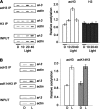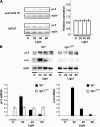The Neurospora crassa White Collar-1 dependent blue light response requires acetylation of histone H3 lysine 14 by NGF-1
- PMID: 16914525
- PMCID: PMC1635368
- DOI: 10.1091/mbc.e06-03-0232
The Neurospora crassa White Collar-1 dependent blue light response requires acetylation of histone H3 lysine 14 by NGF-1
Abstract
Blue light-induced transcription in Neurospora crassa is regulated by the White Collar-1 (WC-1) photoreceptor. We report that residue K14 of histone H3 associated with the light-inducible albino-3 (al-3) promoter becomes transiently acetylated after photoinduction. This acetylation depends on WC-1. The relevance of this chromatin modification was directly evaluated in vivo by construction of a Neurospora strain with a mutated histone H3 gene (hH3(K14Q)). This strain phenocopies a wc-1 blind mutant and shows a strong reduction of light-induced transcriptional activation of both al-3 and vivid (vvd), another light-inducible gene. We mutated Neurospora GCN Five (ngf-1), which encodes a homologue of the yeast HAT Gcn5p, to generate a strain impaired in H3 K14 acetylation and found that it was defective in photoinduction. Together, our findings reveal a direct link between histone modification and light signaling in Neurospora and contribute to the developing understanding of the molecular mechanisms operating in light-inducible gene activation.
Figures






References
-
- Anafi M., Yang. Y. F., Barlev N. A., Govindan M. V., Berger S. L., Butt T. R., Walfish P. G. GCN5 and ADA adaptor proteins regulate triiodothyronine/GRIP1 and SRC-1 coactivator-dependent gene activation by the human thyroid hormone receptor. Mol. Endocrinol. 2000;14:718–732. - PubMed
-
- Avendano A., et al. Swi/SNF-GCN5-dependent chromatin remodelling determines induced expression of GDH3, one of the paralogous genes responsible for ammonium assimilation and glutamate biosynthesis in Saccharomyces cerevisiae. Mol. Microbiol. 2005;57:291–305. - PubMed
-
- Baima S., Carattoli A., Macino G., Morelli G. Photoinduction of albino-3 gene expression in Neurospora crassa conidiation. J. Photochem. Photobiol. 1992;B15:233–238. - PubMed
-
- Baima S., Macino G., Morelli G. Photoregulation of the albino-3 gene in Neurospora crassa. J. Photochem. Photobiol. 1991;11:107–115. - PubMed
Publication types
MeSH terms
Substances
Grants and funding
LinkOut - more resources
Full Text Sources
Molecular Biology Databases

